The Python and I found each other in 2001. I had a drop of blood from one of these constrictor snakes potentised at Helios and the adventure of discovering the Python’s secrets began. Whilst I was conducting the remedy proving I had the idea of taking the Python back to Africa in remedy form. After all, this is where the Python comes from.
In the summer of 2005 I at last got the longed-for chance to fly to Rwanda with my youngest brother and a group of his parishioners. Coincidentally this is an African nation which shares a similar history to that of Nazi Germany and its genocide, which is hard to comprehend. I was able to help out at a medical station in Kaduha which was run by Sister Milgitha who has been working with the poorest of the poor in the mountains of Rwanda for 30 years.
After the genocide of the 1990s, Milgitha founded an orphanage for parentless children who would have starved to death if they had not had help from others who could care for them. Eating disorders are unheard of in this country where all too many people live without knowing where the next meal might come from. The theme of eating is all-pervasive in Rwandan life, more deeply and drastically so than we could ever imagine in the western world. Many children simply starve to death and I saw many malnourished children in Sister Milgitha’s medical station.
Some children had Kwashiorkor (severe protein malnutrition, especially in children after weaning, marked by lethargy, growth retardation, anaemia, oedema, potbelly, skin depigmentation, and hair loss or change in hair colour). You could not tell that they were malnourished. They had fat, almost too fat, little legs and big moon-shaped faces. They had water retention in their heads, stomachs and legs. Quite often they were coffee-coloured rather than black skinned like the other children. Often their hair wasn’t so curly and tended more to blond rather than black. These children also seemed mentally lethargic and reserved.
The Sister told me that many of these children remain mentally retarded even when they get or resume normal nourishment, which at first they refuse to accept. (A small analogy: captured pythons refuse to eat after their capture and if they are force-fed they regurgitate it.) Sister Milgitha did everything in her power to help these children, and I was glad to get the chance to work with and offer homeopathic treatment to one of the many children in the orphanage.
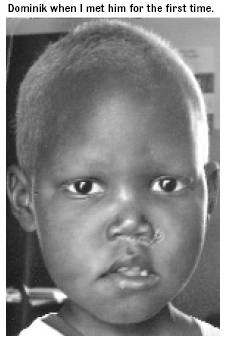
–
This child, Dominik, was suffering from Kwashiorkor. I was allowed to look at Dominik’s official social report and took the following notes: Dominik is seven years old and comes from Gitarama province. He was rejected by his parents when he was three; both parents remarried and Dominik went to live with his grandmother. As she was unable to provide him with sufficient food, he developed the symptoms of Kwashiorkor. His grandmother suspected that he became ill because someone had tried to poison him and this is why, in the first instance, she went to see a witch doctor/traditional healer. At the beginning of January 2005 a neighbour working for the military was able to bring him to the hospital in Kaduha, suffering from severe malnutrition. His grandmother wanted Dominik to be cared for in the orphanage until he had sufficiently recovered. On 26 January 2005 he arrived at Sister Milgitha’s medical station.
Presenting symptoms:
- Generalised oedema
- Loss of hair colour and curl
- Diarrhoea.
In summary, Dominik had suffered from Kwashiorkor since the age of three when his parents cast him out. He was treated at the beginning of January 2005 in the military hospital in Kaduha and then cared for in Milgitha’s orphanage since the end of January.
Six months later, on 1 August 2005, I started his homeopathic treatment. Dominik met me every afternoon during my daily routine at the medical station. After dealing with the ever-calm long queue of patients, usually women with children on their backs, I would go to see the orphans.
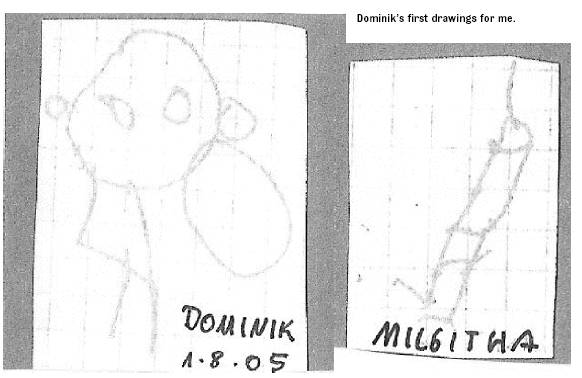
–
They noisily surrounded me with happy faces. They all wanted the chance to shake my hand, so – as Sister Milgitha explained – they could test whether the white colour would come off on contact. There were always children holding my hand and we played a lot of games. Most of them loved dancing and the boys were just as good as the girls. But one of them stood apart. It was Dominik, always separate from the rest of them. He had the typical moon face of Kwashiorkor children and he would hide behind the bench while other children cheerfully surrounded me. He never offered me his hand. He was very shy and his awkward and reserved manner made me feel quite uncomfortable. Although it was a sunny 27C, he wore an overly large anorak from our clothing donations and had a hat pulled over his head. Apparently he was always cold. Dominik never took part in our games, even at the end.
His appearance marked him out as well. His facial skin and hair colour was significantly lighter than that of the other children and he still had scars on his upper lip, left over from the Kwashiorkor illness. He also still had oedema in his face.
I let him draw something all on his own when he was with me. He was very cautious and then produced a teeny weeny picture more appropriate for a three- to four- year-old (see drawing above). It was more or less just a torso without arms and feet. What should I give him, which homeopathic remedy?
His oedema made me think of Python as a remedy. I also thought of the following analogy: In western society with all its excesses, I give Python to children and adolescents who have bulimia, the eating disorder in which, primarily, young girls purge themselves of excess food by vomiting. They never completely drain themselves so you cannot see their illness and they are never as thin as an anorexic. I thought the Kwashiorkor children in Africa seemed similar – because of their fluid retention you cannot see their malnutrition.
So I gave Dominik Python 1M. I gave it to him daily during the 12 days I was there. The first time that I gave him the globules he was very suspicious and would only take them when Sister Milgitha told him to. After I left he took globules once a week for eight weeks.
Treatment results
Every day Dominik became more trusting and on Friday 5 August he came to me of his own accord and collected the globules. He also greeted me with the firm handshake that all the children gave me.
I did not hear anything from Sister Milgitha for six months. It was only in January 2006 that I received news of Dominik when I got photos and the following report from a trainee:
Python has transformed him both spiritually and physically. What has improved in those six months?
- He no longer has a moon face. His face is free of oedema and has regained its natural shape (see photo).
- His skin is as black as the other children.
- His hair is now as black as the other children; he is no longer blond.
- He has lost his sensitivity to the cold and runs around in his t-shirt without an anorak like the other children.
- Spiritually much has changed.
- The drawing is larger. He has drawn a house next to a man and the figure now has distinct features: head, chest and abdomen, arms, hands and feet (see left). The drawing indicates to me a confident child who has clearly matured.
- He dances and proudly shows off his muscles.
- He leads the group in dancing and dances artistically – has maybe discovered something he can do especially well.
- He even quarrelled which was never possible before as he avoided all confrontation.
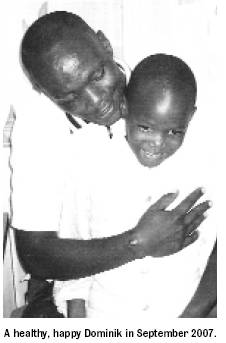
–
The most important is that his development is now normal! It has helped an anxious and withdrawn child, who had lost his curiosity and joie de vivre, to blossom. Dominik was a child who had been neglected and abandoned by both parents and had almost starved as a result. Clearly he had overcome the trauma of abandonment since the use of Python. He feels as though he is now part of the group of other children and no longer feels excluded.
Using Python in a western society
In Germany I have successfully used Python in cases of bulimia, an illness which raises many questions in the west. What does bulimia in our country have in common with Kwashiorkor in Rwanda? In western society no child starves when it is rejected by its parents. Why do eating disorders occur? Do children with eating problems feel emotionally neglected by their mothers? Does the child have the feeling that the mother doesn’t pay it enough attention or give enough time? Or does the bulimic child give the care which it does not get itself to others, for example to the father or siblings? Is bulimia a sign of the emotional starvation of children? Do children find themselves adrift in an industrial ‘soundbite a minute’ society? Do we under-estimate the spiritual hunger of children and is this then substituted with food and maybe also sweet things? I would like to see Python used more and more frequently in both Africa and Europe, and to see its beneficial effects manifest in the development of children.
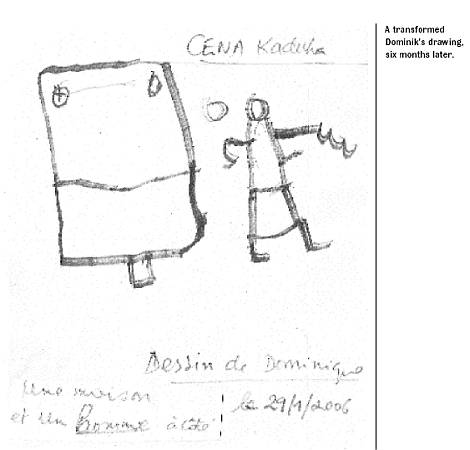
–
Python and the animal kingdom
In this section, bold means association with the animal kingdom, italics with reptiles and snakes.
One important theme which we see in Python is the theme of co-dependency between the weaker addictive partner and the stronger co-dependent partner. The dependent one feels controlled and dominated by the co-dependent. They feel trapped by another’s caring/ smothering. The python lays her eggs in the coils of her body and cares for her young by offering warmth and protection. This is unusual in reptiles. The python is caring, as are patients who need Python as a remedy (see dream ‘Leaving her child’ on page 37).
Another important theme that we see in Python is that of eating disorders and in particular, bulimia. Captive pythons regurgitate their food when they are force-fed, in the same way that bulimics do after secretly gorging themselves. (Reptile: hiding and deceit, attack from behind.)
The problems of children with eating disorders are often not openly discussed but rather furtively referred to, i.e. conspiracy instead of open discussion. The same pattern occurs when co-dependents leave their partners. There are secret discussions, then attacks from the rear.
Both bulimics and co-dependents are always concerned for others and at some stage fail to recognise their own needs. This can sometimes lead to schizophrenia or a split personality. One’s own sexuality is not acknowledged, and in females this can lead to considerable discord between mother and daughter.
Bulimic girls and boys hate themselves, are disgusted with themselves and think they will never find a partner because they are ugly and unattractive. They do not feel they are good enough and they can’t accept themselves. The trigger for illness is the feeling of being neglected and abandoned by the parents, as we saw with Dominik. Within a group he withdraws because he is scared of being rejected and so he becomes isolated. He is also scared of having to compete. After taking Python he becomes aware of his own powers and skills. So he begins to believe that he can compete with the other children. He overcomes his sense of isolation and becomes fully integrated within the group.
Summary of the Python repertory
What follows is a short sketch of the remedy picture, gleaned both from the proving, and also clinically:
Head and eye-region
Pressing headache, vision restricted, strabismus. The eye waters (often one eye); oedema of the lids. The eyes are purulent in the morning, and provers could not open them.Shoulder and neck region
Stiffness and pain in those parts, mostly one-sided.Thermal regulation disturbed
Spells of cold or heat. They have ice-cold hands or feet. This is like the adaptable blood temperature of reptiles. They need warmth from an exterior source.Fluid balance
Oedema in face and feet.Extremities
Paralysis; the limbs are heavy and hard to move because of pains in the joints (one-sided). Pressing pains, or an insensible feeling, in the knees and legs.Heart and lungs
Oppressed feeling. Panic attacks in the night, with a choking feeling in the throat. On taking a deep breath, she felt as if there was a corset round her chest. Fainting.Stomach
Feeling as if stones in the stomach after eating. Belching, heartburn. Pressure on the stomach, which radiates to the heart region.Mind
Depression: feels others’ emotions and forgets or loses her own. A lonely feeling; feels betrayed by the family. They feel as if they are drowning in their suppressed desires.Memory problems: they forget essential things like car keys, purse or account number.
Confusion: they are late for their appointment; they mix up words like ‘hot’ and ‘cold’, or ‘on’ and ‘off’.
There are also many fears, such as fear of:
– being strangled
– suffocation
– marriage
– losing too much blood
– whirlpools
– starvation
– catastrophe
– hurting others.(All these fears express a general anxiety about ‘letting go’. The deepest fear is that of not wanting to hurt others).
Sleep
Falls asleep late, and then wakes between 1-3am.Female sexuality
Orgasm absent (again, this indicates a fear of letting go).
Menstruation is painful and crampy. Much blood flows in dark red clots.
A sensation as if the lining of the uterus is turned inside out (it is as if the woman has sacrificed all her motherly qualities).Wounds
Bleeding stops very fast (clinical).
Python dreams
Dream about snakes (female with snake-phobia)
I am living all alone in a double bed (translation note: continental double beds comprise two single mattresses within a double framework) in the middle of the forest. I am surrounded by colourful snakes. I sit up and watch how easily a snake gets through the crack between the mattresses. I am not afraid and just think how good it is that I got up and then I walked away.
Later she was able to watch a film about snakes.Dream about leaving her child (female)
I had a small child, an infant. I was carrying him and was standing in the market (in Cologne). I put the child down on a stall. He was wrapped up warm. I was interested in something else. I looked back and the child had gone. How awful that I had been interested in something else and so had forgotten the child. I looked everywhere for him. There is a shopping trolley in the park with a black child in it. A woman says: ‘Well, why don’t you take that one?’ ‘No, I don’t want to. I want my child.’ Suddenly I am lying at the edge of the forest on a gravel path breastfeeding the child. Other women are lying there and breastfeeding but they have husbands. It is only me who has no blanket and no husband. I get a blanket from another woman for the pain in my kidneys. The path carries on, slippery enough to sledge on. I couldn’t forgive myself that I had been more interested in other things than in my child.
This article was translated from German by Irene Roberts.

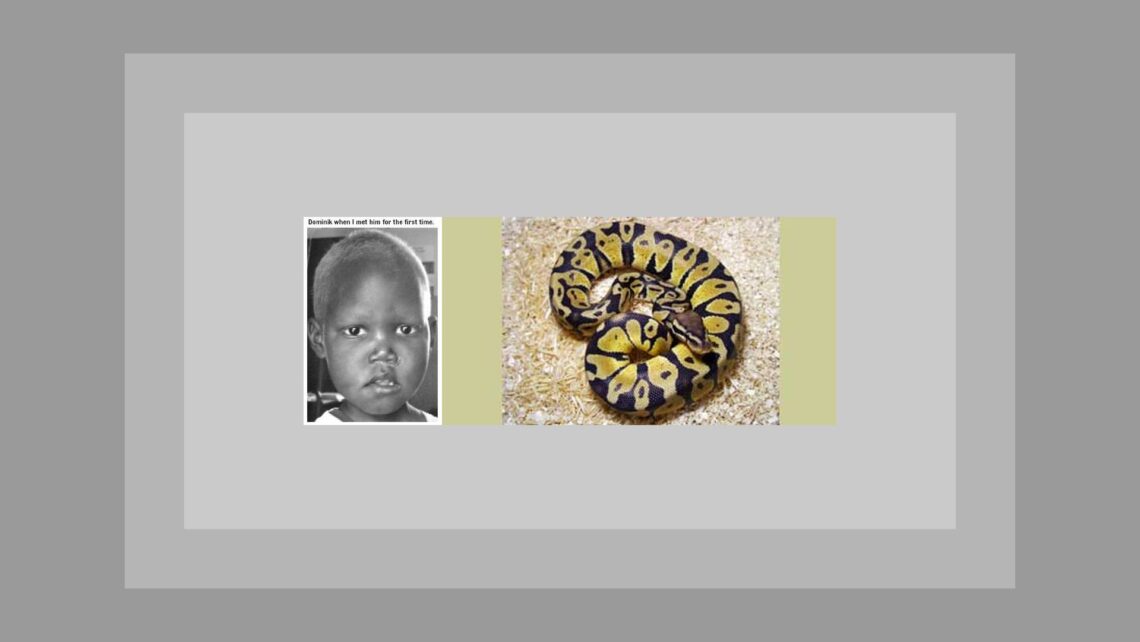
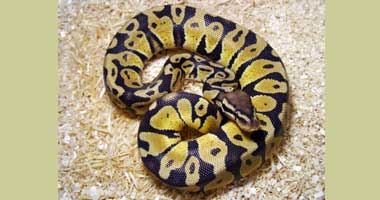 In this section,
In this section, 

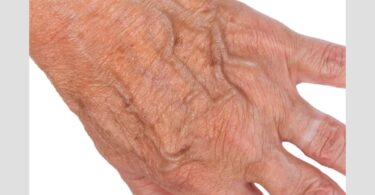

This is the first time I have read about the remedy ‘python’. It is wonderful to find something that can help bulimics.
It was very moving to read about Dominik
it was very excellent .I RED THE FIRST ARTICLE ABOUT PYTHON.THANKS FROM BRIGITTE AND HER ATTEMPT
Well done. It takes a long time to carry out a proving, write it up and then establish the essence of a remedy. Not enough homeopaths are doing it. Your article will be welcome to a whole range of homeopaths, from those approaching cases from a therapeutic level to those working at the deepest level.
Interesting the suspicion of Dominik when first asked to take the remedy – suspicion and refusing remedy both snake symptoms, also the changing skin colour and the suffocation and throat symptoms, would be useful for you to post an addendum on your observations of the differences with other snake remedies, say with NAJA, where the person feels hunted out and picked on
This is a very interesting article; Your devoted work in Africa, Dominik’s case and the proving of Python you shared with us are all of great value and I am very thankful for having the opportunity, through Hpathy ezine, to read and Know about such interesting issue.
I wish you all the best!
dr. Narcisa I.
DEAR SIR
IT IS NOT EASY TO TRY THIS DOMINIC REMEDY. I WOULD BE GLAD IF THE AUTHOR WOULD HAVE GIVEN US A FEW CASES CURED BY HIM
THANKS
DR SHEKHAR
Dr. Gupta, Can you refrain from posting your comments in all CAPS. Please use the standard sentence form for posting your comments.
Thank you for your concise insight to Python I have struggled with a case of bulemia with little succsess. A snake remedy was called for, but non held.I now understand and see clearly. Will write and let you know how she gets on; with case notes. Amicably Delyse.